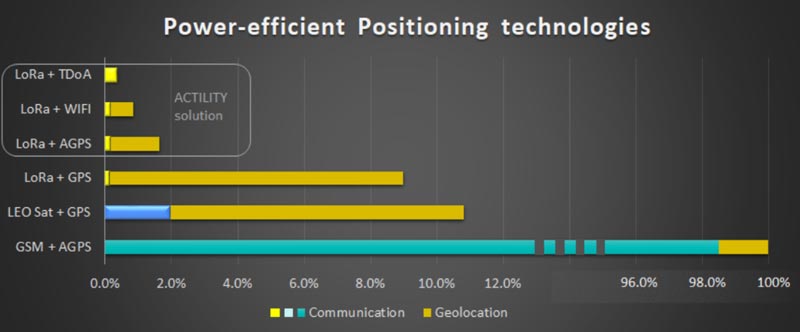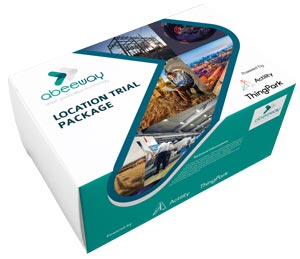


Railway cars, truck trailers, containers: tracking valuable assets on the move is a pain point for most large distributed organizations involved in logistics and supply chain, typically relying on partners such as distributors to correctly register check-in and check-out events. This registration process at specific checkpoints is usually manual, intermittent and subject to human errors. To tackle this issue, an IoT low power asset tracking system using LPWAN (Low Power Wide Area Network) trackers brings a “timeless” checkpoint solution. Specifically, LoRaWAN™-based trackers, because of their low power, low cost and lightweight infrastructure, provide a first truly reliable tracking solution allowing to reduce downtime during transportation.
The challenges involved
In the logistics sector, many business cases involve additional costs due to inefficient utilization of assets. Transport companies need to invest in freight railway cars, car logistics companies need to invest in truck trailers, and of course there are the standard containers and pallets.
“The profitability of these business cases directly depends on the minimization of asset downtime: every day or hour lost in a warehouse, parking or rail station reduces the number of times the moving asset will generate profit in a year.”
However, measuring this downtime is also a challenge. Traditional solutions involved cellular or satellite trackers, which require significant CAPEX, but perhaps more importantly also ongoing OPEX due to battery replacements and connectivity costs. In some cases, trackers are located in hard to reach areas especially when mounted on railroad cars, or in oil and gas rigs, which makes it very costly to replace batteries especially if there are several hundreds of thousands of trackers deployed in the field. The battery replacement is done by humans and is one of the dominating OPEX factors in overall Total Cost of Ownership ( TCO) of the whole solution. These replacement costs actually made it difficult to justify the mass adoption of conventional geolocation solutions in the logistics sector.
LPWAN trackers: a game changer
LoRaWAN is a very recent development leveraged by Actility, the industry leader in LPWAN connectivity, to create disruption in both the technology and business models. On the technology front, the main impact is on drastic reduction of power consumption, which reduces battery usage and ultimately also OPEX related to ongoing maintenance. It also creates new opportunities for more dynamic tracking, as communication events are less costly. On the business model side, logistics companies can now trade off between CAPEX and OPEX: most LPWAN systems operate on an unlicensed band, for example the leading LoRaWAN™ technology operates in the 915MHz band in the US, the 868MHz band in Europe and equivalent ISM bands in other parts of the world. This means that logistics companies can invest in their own wireless networks to reduce or eliminate variable connectivity costs.
“The cost of LPWAN radio network gateways has decreased due to higher production volumes and are now affordable even to very small logistic centers, such as a car distributor. “
Next generation LPWAN trackers
The potential of LPWAN-enabled tracking requires a new generation of hardware. The lower radio frequency power consumption is only a part of a massive effort to decrease overall power consumption of the whole system. And rather than focusing on geolocation technology, Abeeway, Actility’s subsidiary, took the path of developing a smart multi-technology geolocation system fully optimized for LoRaWAN™. Ultra-low power technologies such as TDoA LoRaWAN network triangulation, WiFi sniffing, or BLE beacons, will be used whenever possible, along with the classic GPS optimized through techniques such as Low power GPS and D-AGPS (learn more about our Low power GPS technology here). Trackers from Abeeway were the first to reach sufficient maturity to be deployed in a use case requiring tens of thousands of units, with relatively low-cost assets (such as scooters), which means that reliability, low cost and low power were an absolute must. In the case of asset tracking, dedicated modes such as Start/Stop reporting have been developed: logistic application developers, can trigger the reporting events only when motion stops or starts, but also periodically to increase resiliency.
LoRaWAN and LP-GPS (AGPS/GPS) significantly increases battery lifetime

Merging an IoT network solution such as LoRaWAN with multi-mode geolocation technologies for outdoor and indoor positioning increase by at least a factor of 10 the battery lifetime compared to the standard cellular solution using GSM/AGPS. Source: Actility
Designing LPWAN-based asset tracking: a system view
If you are interested in experiencing low power tracking devices for your use cases, you can test Abeeway trackers using one of our Low Power Location Trial Packages here.

© 2024 Actility’s All Rights Reserved